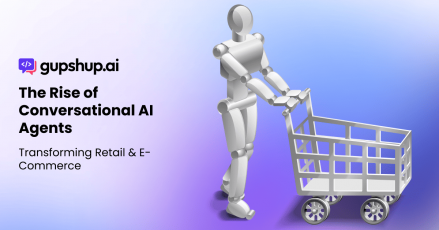Tips And Tricks To Write Prompts That Work For Your Business

AI technologies, especially Generative AI, can be a game changer for your business. Its capabilities in streamlining operations and enhancing customer interactions are truly amazing.
Consider the banking sector. In this sector, generative AI is changing everything from personalized banking services to sophisticated risk management. The potential of AI is unmatched.
In fact, it is predicted that Generative AI has the potential to add between $200 billion and $340 billion annually to the banking industry alone!
Astonishing, right? Yet, there’s a hurdle that many companies face: the complexity of crafting effective AI prompts. This challenge is critical as the efficacy of your AI-driven systems depends heavily on the quality of the prompts you feed them. If the prompts are unclear or poorly designed, the AI’s utility diminishes.
The crux of the matter is this – your AI system must operate with prompts that are meticulously crafted to meet specific operational needs. This ensures relevance and functionality in real-world applications. Remember – the clearer your questions, the better your AI’s answers.
To aid you in enhancing your AI strategy (and hopefully save you countless hours of trial and error), we’re here to guide you through the art of prompt engineering. This will ensure that your AI not only functions but excels in its role within your organization.
Tips and Tricks for Writing Effective AI Prompts

Let’s look at some tips and tricks for writing effective AI prompts that will help your business create a better customer experience and increase brand loyalty.
Craft Clear and Specific Requests
It is important to craft your prompts with extreme precision. You need to focus on explicit details such as the desired outcome, style, tone, and specific context of the response.
But, how can you craft clear prompts? How will you get the desired response from AI systems?
Let’s get started.
It is important to start broadly and gradually narrow down the focus based on initial feedback. This way, you can train your AI systems and move on to more specific, target-oriented requests. Let’s look at a series of prompts and the process of getting to a more targeted approach –
- Generate a report on recent customer engagement trends.
This broad prompt helps establish a baseline understanding of general engagement trends but might yield too wide a range of data.
- Analyze customer engagement trends for e-commerce on WhatsApp and SMS channels using Gupshup’s tools.
This prompt narrows the focus to specific channels, making the AI concentrate on more relevant data sets.
- Examine detailed engagement metrics for online retailers on WhatsApp over the last quarter. Focus on response times and customer satisfaction through Gupshup’s analytics.
This prompt directs the AI to provide a more detailed analysis relevant to recent performance by specifying the time frame and focusing on particular aspects of engagement.
- Using Gupshup’s analytics, provide a comparative analysis of customer response rates and sales conversions – WhatsApp campaigns vs SMS campaigns – in e-commerce for the holiday season.
This prompt asks for comparative analysis, allowing for a direct evaluation of the effectiveness of different strategies implemented via Gupshup’s platform during a key sales period.
- Suggest optimizations for WhatsApp campaign strategies in e-commerce based on the analysis of last quarter’s customer engagement data from Gupshup’s system. Focus on improving sales conversions for upcoming promotions.
The final prompt in the series uses the data and insights gathered previously to request actionable recommendations, ensuring the output is both practical and tailored for future strategy enhancements.
Each step in this series of prompts is designed to guide the AI towards delivering more precise and actionable insights. This method ensures that the final output is directly applicable to improving business strategies.
Use Open-Ended Questions and Provide Context
Do you know what happens when you provide open-ended questions with ample context?
It enables your AI tool to deliver more informative and comprehensive answers. This can help your businesses expand and innovate. Open-ended questions allow for a more detailed and nuanced collection of data, which can be crucial for developing informed strategies and addressing complex issues more effectively.
Let’s say a company initially used Gupshup’s Bot Studio to deploy simple yes/no questions for customer feedback on service quality. The responses, while easy to analyze, offered limited insights.
Transitioning to open-ended questions could involve prompts like, “Could you describe what you liked about our service today and what could be improved?”
Such questions, facilitated by Gupshup’s AI capabilities, would allow the company to capture more detailed feedback, revealing specific elements that contribute to the customer experience. This richer data could lead to more tailored service improvements and more strategic decision-making.
Analyzing responses from open-ended questions does present challenges, such as the need for more sophisticated data processing techniques. However, the detailed insights gained are invaluable. These insights can uncover unexpected findings and novel ideas, providing businesses with opportunities to innovate and solve problems in ways they hadn’t considered before.
Incorporating Feedback Loops for Refinement
Incorporating feedback loops into AI interactions is another strategic approach that significantly enhances business operations. It enables continuous improvement and alignment with user expectations.
Gupshup’s Conversational AI platform exemplifies the strategic integration of feedback loops. The platform utilizes advanced components like Natural Language Processing (NLP) and Machine Learning. This facilitates the AI’s ability to learn from interactions and refine its responses. This ensures that the system not only understands and responds effectively in real-time but also continuously improves its accuracy and relevance based on user feedback.
A feedback loop handles multiple characters in a simulated environment. By focusing on a single “actor” agent for all roles, the system can better manage and rectify its mistakes, such as hallucinations (errors) occurring when differentiating between characters.
Let’s consider an AI system used in e-commerce customer service. Initially, the AI can handle simple queries, such as order status or return policies. However, it struggles with complex issues, like resolving disputes or providing tailored recommendations.
Initial Prompt: “How can I help you today?”
Feedback: Customers often ask multiple questions, causing the AI to respond only to the first query.
Improved Prompt with Feedback Loop: “I see you have multiple questions. Let’s address them one at a time. What’s your most urgent issue?”
Outcome: This prompt directs the AI to engage in a step-by-step interaction, ensuring all customer concerns are addressed.
How is it beneficial for businesses?
- It allows AI to self-correct through feedback.
- It enhances reliability and performance in tasks involving complex interactions or multiple variables.
This method improves the AI’s understanding and response accuracy over time, which is important for applications requiring precise and adaptable AI functionalities.
Businesses can also use feedback loops to correct errors and use positive feedback to drive growth. They allow companies to identify successful strategies and amplify them.
For example, positive feedback on a new product feature can encourage a business to invest further in that area, enhancing product offerings and potentially increasing market share. On the other hand, negative feedback helps companies quickly identify and rectify issues, maintaining stability and efficiency within their operations.
Gupshup’s platform, by incorporating feedback loops, demonstrates how businesses can systematically collect, analyze, and act on feedback to enhance their products, services, and customer interactions. This ultimately leads to growth and a stronger competitive edge in the market.
Enhancing Communication with AI: Flexibility in Tone, Style, and Content Creation
Artificial intelligence (AI) systems demonstrate remarkable versatility in adapting to various professional tones and styles, making them invaluable across different sectors.
Gupshup’s Conversational Cloud can mimic tones using sentiment analysis and steer the conversation with that intent. This adaptability ensures that communications are always aligned with the intended audience, whether the conversation is casual or formal.
This capability extends to completing sentences, where AI can provide focused direction to incomplete thoughts, enhancing clarity and coherence. Additionally, AI excels in generating illustrative examples and creative content, aiding in explanations, marketing, education, and more. This adaptability not only streamlines workflow but also enriches user engagement and understanding, showcasing AI’s utility in diverse professional contexts.
Embracing the Future of AI-Driven Communication
As technology evolves, integrating advanced AI communication tools becomes crucial for businesses aiming to enhance customer interactions and operational efficiencies. Leveraging platforms like Gupshup not only streamlines communication processes but also optimizes customer engagement through personalized interactions.
Embracing these technologies helps businesses adapt to consumer needs dynamically, promoting sustained growth and competitive advantage in the digital age.
Discover the future of communication with Gupshup and transform your customer engagement strategies today.




